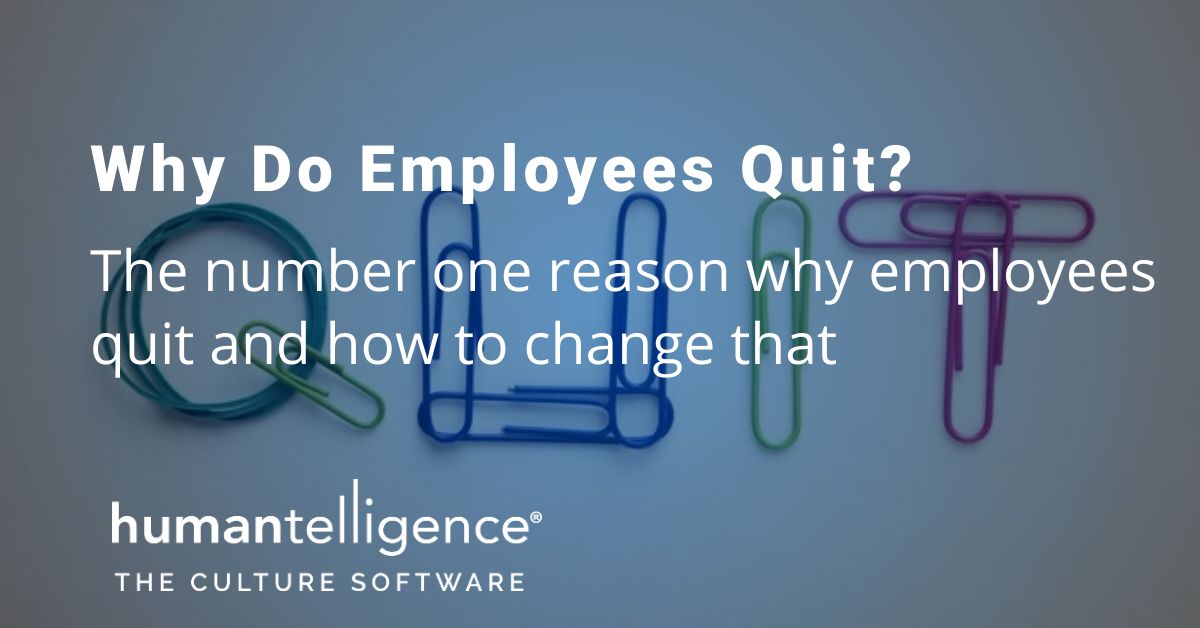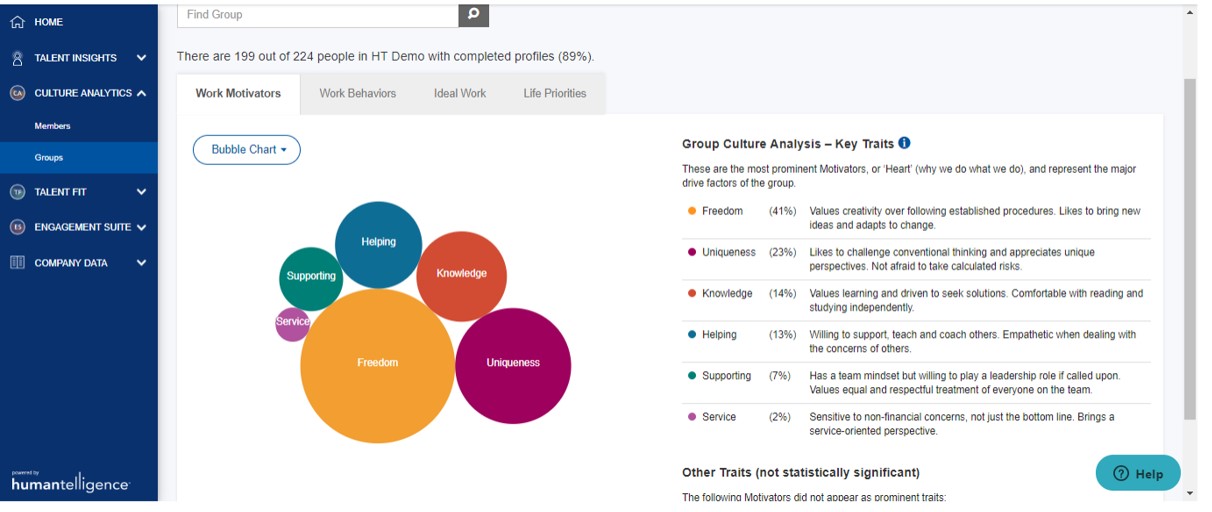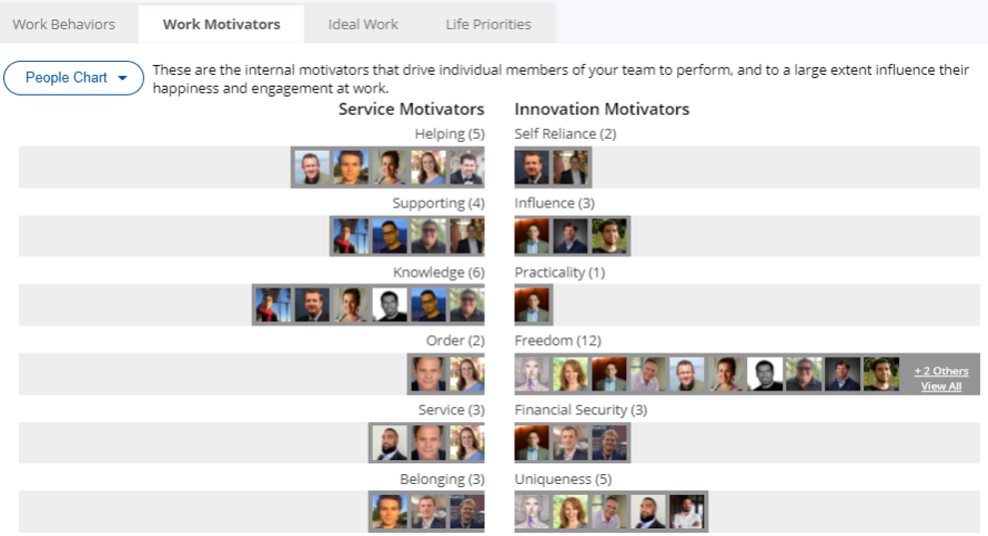Why Do Employees Quit?
- August 10, 2021
- Humantelligence

Why do employees quit? …A question more relevant than ever before.
A reported 3.6 million Americans quit their jobs in May, making one job opening for every unemployed worker — this coming on the heels of April’s 20-year record high, where just shy of 4 million workers left their jobs. Some have called it the Great Resignation.
And as the saying goes, no one likes a quitter…but in this case, it just makes sense. Management & Leadership Consultant Natalie Schrogl asked this question of her network, and the results were insightful. Most might assume people leave jobs because of better, high-paying opportunities. However, of the 5,835 votes, nearly 75% said they have quit a job because of toxic leadership. With more than 4,300 people indicating toxic leadership as the primary reason for departures, it appears the most impactful way to retain your employees is to focus on leadership development.
Toxic Leaders: 74%
No Promotion: 7%
No Pay Increase: 11%
New Challenge: 8%
In that same poll, Schrogl also shared the following anecdote.
I did an executive leadership training with a company last year. And the CEO complained about hiring poor managers.
He said they lose their motivation as time goes on. And he had to change them over time. I asked him, “When last did any of your employees question or challenge your decision? Have they ever had the courage to tell you that you are wrong?”
He couldn’t think of any scenario. I told him he was not running an open style of leadership. Your managers nag behind you, but they can’t look you in the face to speak their minds. And you wonder why they are not motivated?
You are the reason. If you hire one thousand managers, they will all leave when they feel subjected to your order. You are running a team of humans and not bots.
No manager will stay motivated under subjective leadership.
Employees will perform better in a place where they feel valued.
Nic Danko, CEO and Co-Founder of Symple — a payment processing solutions provider — added to the conversation: “There’s certainly an argument for one, a combo or all of the above; however, toxicity can tear an organization apart, from the inside out. It’s felt by other members in the organization and clients can sense it as well. I’m not surprised where the vote of this poll stands at the moment, but I will be surprised if it doesn’t hold by the time the poll closes.”
So often good employees choose to leave because of leadership — or lack thereof. People don’t quit jobs after working at a company for years because they don’t like the job function. They resign because they don’t like the boss or their leadership. Think of it this way, how often has a good employee left your company only to go work somewhere else doing essentially the same role? The answer is very often. They didn’t leave because they don’t like the work; they left because they didn’t like who they were doing it for.
So let’s talk about what toxic leadership looks like and what really motivates good employees — and as this poll shows, it often isn’t just the money.
What’s Bad or Toxic Leadership?
A toxic leader is a person who has responsibility for a group of people or an organization, and who abuses the leader–follower relationship by leaving the group or organization in a worse condition than when they first found them. Toxic leaders must not be confused with leaders who make mistakes. We all make mistakes and get things wrong from time to time. The difference is whether we treat it as a learning opportunity or keep doing the same thing over and over again.
According to Leadership Forces, toxic Leaders are self-serving. They do not care about the organization or the people within it. They treat them as a vehicle to help them get where they want. They are motivated by personal ambition and usually lack self-awareness. Leadership Forces categorize the following six key characteristics of toxic leadership:
Autocratic
The leader makes the most out of their position and authority to make things happen. They impose their will without stopping to consider the ideas and opinions that come from their team. They are focused on maintaining tight control and are intolerant of mistakes. Communication tends to be directive and top-down rather than ‘two-way’.
You can spot people who have a tendency towards these characteristics through their language. They might say things like:
‘We don’t have time to discuss this…’
‘This is the situation and this is what you are going to do’
‘I’ve got so much on my plate…’
They complain about not having enough time because they are poor at delegation. The only jobs they delegate are the ones they don’t want to do. They view delegation as a way of ‘making life easier for me’ rather than developing their team members.
Narcissistic
Narcissistic leaders have an exaggerated sense of their own importance. They believe that they are special in some way. They have an excessive need for admiration from other people and lack empathy when dealing with others. They might say things like:
‘I did/achieved this…’ They rarely point to the work of the team that contributed to the success.
“Your personal problems should be left at home, you’re here to work.’
Like all toxic leaders, these traits can deliver success in the short-term.
Manipulative
The manipulative leader is similar to the narcissist as their focus is still on themselves. These individuals will abuse their position, relationships, and organizational systems for their own gain.
They’re harder to spot than the narcissistic leaders as they are often sneaky and hide their activities. They know deep down that what they are doing is wrong but they will justify their behavior by saying things like ‘it’s not personal, it’s business.’
Intimidating
The intimidating leader will bully their subordinates and those around them to achieve their aim. They are manipulative and have a tendency towards ‘ruling with an iron fist’. Their subordinates will not offer ideas or challenge them for fear of disapproval or ridicule.
Overly Competitive
The overly competitive leader has a ‘win at all costs’ attitude often leaving a trail of damaged and broken individuals who have failed to keep up with their pace. They have a win at all costs attitude that means that they are quick to make decisions and rarely have time for input.
They think that they have high standards and are inspiring. In reality, they create more losers than winners.
Discriminatory
The last toxic characteristic is that of the discriminatory leader. They do not value diversity and surround themselves with people of the same ilk. These leaders do not want to be challenged by people with different points of view so they surround themselves with ’yes’ men.
Damian Hughes describes these people well. In his work with professional sports teams, he’s found managers who surround themselves with ‘truth tellers’ or ‘time tellers.’
When down 1-0 in a 60-minute game, a coach might turn to his coaching staff and say, ‘what do you guys think?’
The time tellers will purse their lips and say ‘there is 30 minutes to go.’
The truth tellers will tell them what they think they should do – even if it is the message they don’t want to hear. For example, ‘take your son off, he’s having a bad game…’
There is a significant difference. One of these people has courage and provides value.
These six characteristics rarely live in isolation. Toxic leaders tend to lean towards being a combination of a few of these behaviors. Either way, they are focused on the short-term game and what they can get out of a situation as opposed to the long-term game and what is best for the organization and the team.
If left unchecked, toxic leadership is what leads to a toxic culture.
How to Fix Toxic Leadership
The impact of not recognizing and addressing toxic leadership is significant. Companies with high levels of employee engagement and strong leadership practices outperform those with low levels of engagement and poor leadership. The business benefits are undisputed and profound. They include:
Retention of high-potential employees
Improved pipeline for succession management
Higher levels of customer satisfaction
Personal satisfaction for leaders who participate
Stronger innovation
Strategic focus on the future vs. tactical focus on the present
Growth in top-line revenue
Savings in expenses
Improved profitability
Increased rates of productivity
The impact of toxic leadership is a negative one in all ten of the areas listed above. Ultimately, due to the high turnover rates and related domino effect on productivity, customer satisfaction, and revenue, a company’s profitability and overall health suffers greatly when toxic leadership is not addressed.
We affirm the research that demonstrates that human factors are more important than financial when measuring success. Results do matter but how the results are achieved matters even more. It’s about the way we treat each other, ensuring that people are the priority, not just the profits. Phenomenal leaders recognize that how we do things around here — our behaviors — is crucial, asking questions like:
How are we challenging each other?
How do we support one another?
How are we connecting?
How are we respecting one another?
Leaders that neutralize toxicity will invest time, action, and money in:
Breaking down silos, and the conditions that create Us vs. Them environments
Confronting toxic attitudes like anger, rudeness, and disrespect regardless of the apparent success of the perpetrator;
Team morale, ensuring that everyone has a sense of purpose in their work;
Rewarding a good attitude as well as great results.
Penalizing bad attitude regardless of results;
Compassion and serving rather than dictating;
Jim Collins, leadership expert and author of Good to Great argues that the best leaders:
allow other people to take the credit and channel their ego needs away from themselves into the larger goal of building a great company
reward great attitude, not just results
challenge bad attitudes and behaviors regardless of results
recognize that charisma can be as much a liability as an asset
look in the mirror, not out of the window, when performance is poor, taking personal responsibility and learning from the experience
look out of the window and not in the mirror to apportion credit for the success, putting the spotlight onto others for their excellence.
How can leaders develop these qualities and ensure that toxicity doesn’t take hold?
The answer lies in focusing on emotionally intelligent leadership — which includes raising their self-awareness, regulating their responses to life’s changes and pressures, enhancing their understanding of others, and being positively motivated to establish and focus on productive and purposeful goals.
The Key to Employee Retention & Engagement
The other part of addressing why employees quit is about better understanding their motivation and values. There’s a science to it, and it’s different for everyone.
To us, it’s about unlocking a team member’s potential — uncovering the what, how, and why of those on your team — specifically by using a psychometric test to better understand an individual’s B-M-W, that is their behaviors, motivators/values, and work energizers. And it’s a two-way street…we know that when people better understand their success factors and are more deeply engaged in their work, they feel more aligned with their company and professional purpose. Organizations improve productivity, increase engagement, and strengthen culture — it’s a win-win for everyone.
A desire to identify and address both the critical strengths that propel teams to excellence and the blind spots holding your team back remain the basis for advancing the leadership and success of any organization and at the core of the work that we do.
Anyone can try the complimentary version of our self-assessment here and receive your top behavioral tendencies and persona summary! Contact us for a full team culture mapping.

